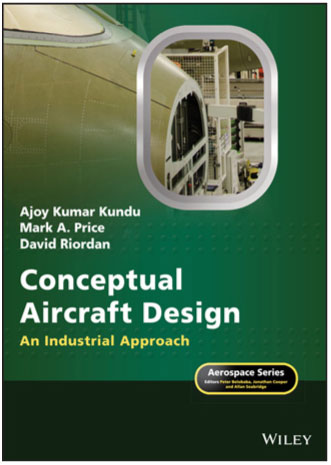
This is a textbook on aircraft design aimed specifically at undergraduate students. The authors bring their considerable joint experience both in industry and as teachers to provide a text aimed at supporting a university course in aircraft initial design.
The core is a set of worked examples through which are followed each of the principal stages of a conceptual design. These are a family of civil business jets, a military turboprop trainer and an advanced military jet trainer, all types with which the authors are very familiar. Students are encouraged to use these as examples to follow in creating their own coursework design studies. The authors argue for the need to prepare the student for real-life problem-solving as distinct from academic structured material with unique answers. They claim learning aircraft design needs to involve number crunching, working in a team and is best done with a relatively well-known aircraft type, rather than a novel non-existent one, so that comparisons with existing alternatives may be made.
The scope is suitably broad for an introductory text, covering not only a quick historical survey and the basic aerodynamics, but matters important to industry including market needs, manufacturing and overall costing. It keeps strictly to fixed-wing aircraft, predominantly subsonic, and states clearly those areas not covered in detail. There are sections that briefly introduce supersonic flight and the emerging opportunities for electric propulsion.
There is much good material here with a balance of topics. The student is given a clear insight into the very wide range of factors to be considered when setting out to create a satisfactory overall design with commercial potential.
The ‘industrial approach’ refers to the authors’ practical expectation that the student aiming to take up design as a career will most likely go to work in a major company and should be given some insight into the working practices to expect.
Part I gives an overall introduction including aerodynamic fundamentals, wings, bodies and tail, aircraft statistics and configuration choices. Part II develops the example designs through a number of steps – layout, undercarriage, weight and centre of gravity, drag, powerplant integration, and sizing including family derivatives, aircraft performance and cost considerations. Part III looks at further aspects including loads, stability, materials and structures, manufacturing considerations and aircraft systems.
While acknowledging that the design process is a highly iterative one, the authors have tried to give a ‘linear’ development through the book from one topic to the next. The use of a small diverse suite of examples to tie things together is commendable. However, the linearity is rather lost in the text, with considerable cross-referring.
This is a very large book, perhaps 50% longer than D. P. Raymer Aircraft Design: A Conceptual Approach (American Institute of Aeronautics and Astronautics. 2018 – Sixth edition). The reason appears to be the excess of repetition. Some points are made over and over, and on some pages, statements or even whole paragraphs are repeated in only slightly modified form. The style is verbose. Frequently poor grammar and minor errors create apparent contradictions and ambiguities. Numerous references are made to Kundu’s earlier textbook Theory and Practice of Aircraft Performance (John Wiley. 2016), which is recommended as a companion volume. It gives more detailed performance analyses of the same example aircraft, but at least a half of that book has been repeated in the present volume.
What seems missing is the clear succinct presentation of the completed design proposals that industry would expect for management review, the university should expect from completed coursework and surely the student will look for in model examples.
This could be an excellent textbook, but it needs significant editorial tidying.


